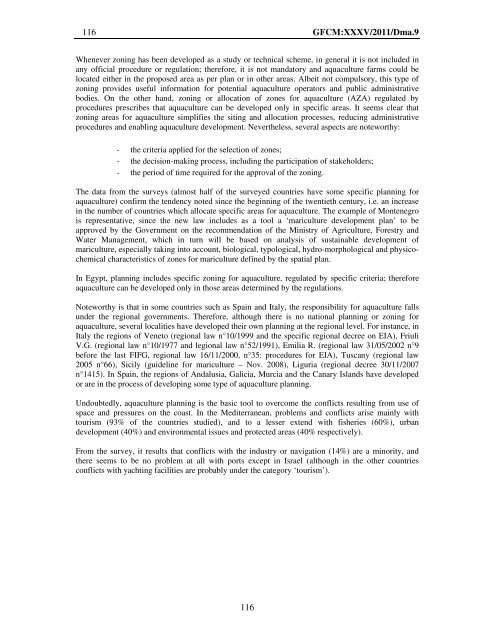Site selection and carrying capacity in Mediterranean ... - FAO Sipam
Site selection and carrying capacity in Mediterranean ... - FAO Sipam
Site selection and carrying capacity in Mediterranean ... - FAO Sipam
You also want an ePaper? Increase the reach of your titles
YUMPU automatically turns print PDFs into web optimized ePapers that Google loves.
116 GFCM:XXXV/2011/Dma.9<br />
Whenever zon<strong>in</strong>g has been developed as a study or technical scheme, <strong>in</strong> general it is not <strong>in</strong>cluded <strong>in</strong><br />
any official procedure or regulation; therefore, it is not m<strong>and</strong>atory <strong>and</strong> aquaculture farms could be<br />
located either <strong>in</strong> the proposed area as per plan or <strong>in</strong> other areas. Albeit not compulsory, this type of<br />
zon<strong>in</strong>g provides useful <strong>in</strong>formation for potential aquaculture operators <strong>and</strong> public adm<strong>in</strong>istrative<br />
bodies. On the other h<strong>and</strong>, zon<strong>in</strong>g or allocation of zones for aquaculture (AZA) regulated by<br />
procedures prescribes that aquaculture can be developed only <strong>in</strong> specific areas. It seems clear that<br />
zon<strong>in</strong>g areas for aquaculture simplifies the sit<strong>in</strong>g <strong>and</strong> allocation processes, reduc<strong>in</strong>g adm<strong>in</strong>istrative<br />
procedures <strong>and</strong> enabl<strong>in</strong>g aquaculture development. Nevertheless, several aspects are noteworthy:<br />
- the criteria applied for the <strong>selection</strong> of zones;<br />
- the decision-mak<strong>in</strong>g process, <strong>in</strong>clud<strong>in</strong>g the participation of stakeholders;<br />
- the period of time required for the approval of the zon<strong>in</strong>g.<br />
The data from the surveys (almost half of the surveyed countries have some specific plann<strong>in</strong>g for<br />
aquaculture) confirm the tendency noted s<strong>in</strong>ce the beg<strong>in</strong>n<strong>in</strong>g of the twentieth century, i.e. an <strong>in</strong>crease<br />
<strong>in</strong> the number of countries which allocate specific areas for aquaculture. The example of Montenegro<br />
is representative, s<strong>in</strong>ce the new law <strong>in</strong>cludes as a tool a ‘mariculture development plan’ to be<br />
approved by the Government on the recommendation of the M<strong>in</strong>istry of Agriculture, Forestry <strong>and</strong><br />
Water Management, which <strong>in</strong> turn will be based on analysis of susta<strong>in</strong>able development of<br />
mariculture, especially tak<strong>in</strong>g <strong>in</strong>to account, biological, typological, hydro-morphological <strong>and</strong> physicochemical<br />
characteristics of zones for mariculture def<strong>in</strong>ed by the spatial plan.<br />
In Egypt, plann<strong>in</strong>g <strong>in</strong>cludes specific zon<strong>in</strong>g for aquaculture, regulated by specific criteria; therefore<br />
aquaculture can be developed only <strong>in</strong> those areas determ<strong>in</strong>ed by the regulations.<br />
Noteworthy is that <strong>in</strong> some countries such as Spa<strong>in</strong> <strong>and</strong> Italy, the responsibility for aquaculture falls<br />
under the regional governments. Therefore, although there is no national plann<strong>in</strong>g or zon<strong>in</strong>g for<br />
aquaculture, several localities have developed their own plann<strong>in</strong>g at the regional level. For <strong>in</strong>stance, <strong>in</strong><br />
Italy the regions of Veneto (regional law n°10/1999 <strong>and</strong> the specific regional decree on EIA), Friuli<br />
V.G. (regional law n°10/1977 <strong>and</strong> legional law n°52/1991), Emilia R. (regional law 31/05/2002 n°9<br />
before the last FIFG, regional law 16/11/2000, n°35: procedures for EIA), Tuscany (regional law<br />
2005 n°66), Sicily (guidel<strong>in</strong>e for mariculture – Nov. 2008), Liguria (regional decree 30/11/2007<br />
n°1415). In Spa<strong>in</strong>, the regions of Andalusia, Galicia, Murcia <strong>and</strong> the Canary Isl<strong>and</strong>s have developed<br />
or are <strong>in</strong> the process of develop<strong>in</strong>g some type of aquaculture plann<strong>in</strong>g.<br />
Undoubtedly, aquaculture plann<strong>in</strong>g is the basic tool to overcome the conflicts result<strong>in</strong>g from use of<br />
space <strong>and</strong> pressures on the coast. In the <strong>Mediterranean</strong>, problems <strong>and</strong> conflicts arise ma<strong>in</strong>ly with<br />
tourism (93% of the countries studied), <strong>and</strong> to a lesser extend with fisheries (60%), urban<br />
development (40%) <strong>and</strong> environmental issues <strong>and</strong> protected areas (40% respectively).<br />
From the survey, it results that conflicts with the <strong>in</strong>dustry or navigation (14%) are a m<strong>in</strong>ority, <strong>and</strong><br />
there seems to be no problem at all with ports except <strong>in</strong> Israel (although <strong>in</strong> the other countries<br />
conflicts with yacht<strong>in</strong>g facilities are probably under the category ‘tourism’).<br />
116
















